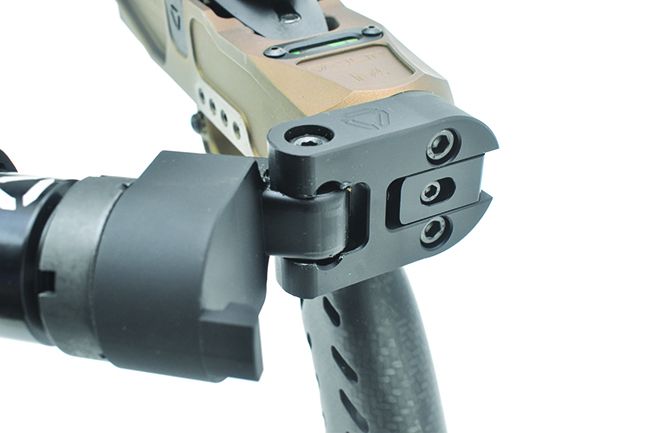The 6.5 PRC (Precision Rifle Cartridge) was designed by George Gardner of GA Precision and finalized and formalized by Hornady and then introduced at the 2018 SHOT Show. It is essentially a “magnumized” 6.5 Creedmoor (CM), using heavy-for-caliber, high-ballistic-coefficient bullets that require fast-twist barrels. Also like the 6.5 CM, the 6.5 PRC mandates short, fat cartridge cases along with very tight tolerances throughout the chamber. The result, like with the Creedmoor, is an accurate long-range-capable cartridge without a ton of recoil. Industry reports tell us that the 6.5 PRC is one of the fastest-growing cartridges in the long-range and hunting segments of the rifle world. Also, this is one of the cartridges you have searched for most frequently in our archives, so we thought this report was an absolute must.
Rifles capable of long-range shooting can quickly find themselves too heavy to carry in the field. We have also discovered that, as we age, we increasingly dislike weight and recoil in our rifles, so we set out to find up-to-date rifles chambered in 6.5 PRC that won’t tweak our backs or dislocate our shoulders. Our pocketbooks might be strained, however, because light and powerful can also be expensive, and because of the carbon-fiber-wrapped barrels on these rifles, the price tags are up there.
The first sample we chose was a Christensen Arms MPR (Modern Precision Rifle) $2400. As mentioned, the MPR sports a carbon-fiber-wrapped barrel designed to keep the tube as light weight, stiff, and cool as possible. The fore end and cheek piece are also carbon fiber and are mounted to a sculpted aluminum chassis.
Our first look at a Christensen Arms MPR came in the April 2021 issue where we examined it against long-range PRS-style rifles. And it almost won. The rifles in that comparison were chambered in 6mm Creedmoor. Here, we went to a heavier chambering and a lighter rifle. The 6.5 PRC is all about ballistics and down range energy. Where our 6 CM reloads pushed 2975 fps with a 109-grain bullet, and 6.5 Creed rounds are more in the 2700 fps range with 140-grain bullets, our 6.5 PRC loads were in the 2875 fps range with a 156-grain bullet. That launches a bullet with almost 2900 foot-pounds of energy at the muzzle and supersonic flight to about 1650 yards. That gives the hunter elk-worthy energy (at least 1500 foot-pounds) beyond 1600 yards. Please remember that just because you can shoot at extended ranges does not mean you should at extended ranges.
The second test rifle was a fully adjustable Springfield Armory Waypoint 2020, $2400. Using a carbon-fiber stock from AG Composites in the Evergreen camo pattern, the Waypoint offers a more conventional camo pattern for the stock, which some shooters will prefer.
Next came the brand-new Bergara MgLite rifle, $3000. Also a chassis-mounted system, the Bergara brings a minimalist design to the game.
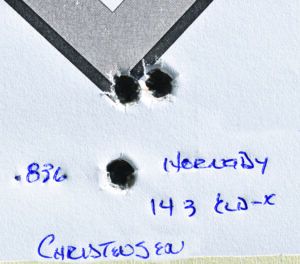 We were expecting a great deal from these rifles, and to get the most from them, we needed a top-shelf optic. So we secured a Leupold Mark 5HD 3.6-18×44, a first-focal-plane scope equipped with the TMR reticle. At 26 ounces, the Mark 5HD is not super light, nor is it a monster to hump up a hill. The 3.6- to 18-power magnification gives us plenty of coverage for the field, and the 44mm objective is one of our favorite diameters — not so large that it has to be mounted with extra-tall rings, while still wide enough to get sufficient light to our eyes. At less than 12 inches in length, this Leupold packs a lot of features into a short tube that looks and works right on short or long rifles. We used Leupold 35mm rings to attach the glass to Picatinny rails on the rifles.
We were expecting a great deal from these rifles, and to get the most from them, we needed a top-shelf optic. So we secured a Leupold Mark 5HD 3.6-18×44, a first-focal-plane scope equipped with the TMR reticle. At 26 ounces, the Mark 5HD is not super light, nor is it a monster to hump up a hill. The 3.6- to 18-power magnification gives us plenty of coverage for the field, and the 44mm objective is one of our favorite diameters — not so large that it has to be mounted with extra-tall rings, while still wide enough to get sufficient light to our eyes. At less than 12 inches in length, this Leupold packs a lot of features into a short tube that looks and works right on short or long rifles. We used Leupold 35mm rings to attach the glass to Picatinny rails on the rifles.
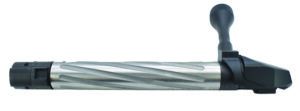
All three barrels have 1:8-inch twists, suitable for longer projectiles. Most of the factory ammunition we’ve seen has been in the 130- to 147-grain weight range. Velocities more than 3000 fps are possible, but we felt this cartridge could do better. We started experimenting with Berger 153- and 156-grain bullets more than two years ago and have been very pleased with the results on multiple 6.5 PRC platforms. We thought that would be the thing to do here as well. The Berger 153.5-grain Long Range Hybrid Target and 156-grain EOL Elite Hunter both did very well when pushed by near-maximum charges of VihtaVuori N565, N560, and Hodgdon H1000 powders. We lit the charges with CCI BR2 Large Rifle Benchrest primers. We assembled loads on Redding match dies. We finally admitted that we were tired of doing tons of case trimming with arthritic hands and bought a Henderson Precision power case trimmer. The trimmer and a few extras cost us about $900, including the motor, but then allowed us to do in minutes what used to take us days. Very easy to use, and we don’t think that we have ever seen a smoother or more precise chamfer on our trimmed cases.
Here’s how these bolt actions performed:
Gun Tests Grade: A (Our Pick)
$3000
We first examined some 6.5 PRC rifles in the November 2020 issue. We were very impressed with the Bergara Premier Mountain 2.0 rifle at that time and found nothing in the new MgLite that changed our mind. The “Mg” represents magnesium that is the primary component in the chassis instead of the more common aluminum.
| Action Type | Bolt |
| Overall Length | 43.0 in. |
| Barrel Length/Twist | 24.0 in., 1:8 |
| Overall Height w/o Scope Mount | 6.9 in. |
| Weight Unloaded | 6.7 lbs. |
| Weight Loaded | 7.2 lbs. |
| Sight Radius | NA |
| Action Finish | Black Cerakote |
| Barrel Finish | Black Cerakote |
| Magazine Capacity | 3 |
| Magazine Type | Detachable box, AICS compatible |
| Stock | Magnesium chassis, AR-style buttstock |
| Drop at Comb | 0.5 in., adjustable |
| Drop at Heel | 0.6 in. |
| Bedding | Action screws through metal chassis |
| Buttplate | 0.5 in., rubber |
| Length of Pull | 13.75 in. |
| Receiver Scope-Base Pattern | Remington 700 |
| Trigger Pull Weight | 1.4 lbs. |
| Safety | Two-position rocker |
| Warranty | None specified |
| Telephone | (877) 892-7544 |
| Website | Bergara.online/us |
| Made In | U.S. |
When you add in the sleek design of the chassis, the carbon-fiber-wrapped barrel along with more carbon fiber in the cheek piece, and the very cool-looking pistol grip, you wind up with an unscoped rifle that weighed in empty at a mere 6.7 pounds.
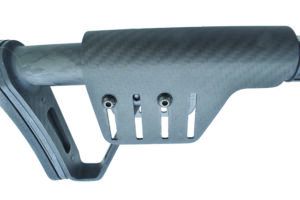
The use of magnesium was not the only thing that made the chassis different. First the bad — the magazine release was a small lever that protruded below the front edge of the trigger guard. We don’t want mag releases to be easy to activate unintentionally, but we really don’t like to have to shift our grip to release the mag. The spring was stiff enough and the lever small enough that we had to use a thumb from one of our hands to drop the mag. OK, that’s all for our gripes. We wish all our lists were that short.
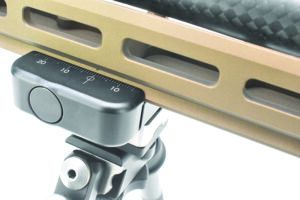
The remainder of the stock had a number of the features we thought notable. In what must be a cost-saving move for Bergara, the sides of the receiver are both inlet to allow the closing of a bolt handle. Ours being right-handed, the left side was plugged. Being on the very popular Remington 700 footprint, we wonder if these stocks might be available at some future date as an aftermarket part. As it is, they are virtually ready to go for a right- or left-handed action. The fore end is very rigid and allows substantial room to free-float the barrel, even if someone decides to install a slightly larger tube. M-Lok grooves have been cut at the 3, 6, and 9 o’clock positions, very useful for the addition of a Picatinny rail. Then Bergara machined an ARCA Swiss rail into the bottom of the fore end. This would be perfect for the use of specific bipods, tripods, or saddle-type attachment mounted on tripods for hunting afield.
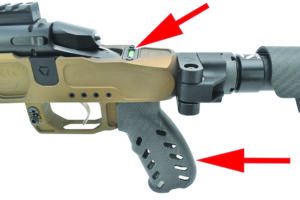
We’re not done with the chassis yet. It ends with an attachment that allows the use of an AR-15-style buttstock. Any of them. Just loosen the castle nut and pop on whatever your heart desires. We don’t think we would change the supplied XLR stock for our purpose. Not only is the buffer tube and the bracing made of carbon fiber, but so is the adjustable cheek piece. Before you ever get to that castle nut is a sturdy hinge that, when the right button is pushed, allows the stock to be folded to the left. There is even a bubble level visible just in front of the hinge. The AR-style pistol grip is also made from carbon fiber. An AISC-style three-round magazine from Accurate Mag is provided and fits in a nicely beveled magwell.
The rifle comes with a Trigger Tech trigger. Required trigger compression on our sample, after adjustment, averaged a mere 1.39 pounds. The slim bolt handle ends with a hollowed-out bolt knob that was easy to find and operate. The fluted bolt has dual lugs, dual plunger-style ejectors, and a sliding extractor. The tip of the striker protrudes, thus doing double duty as a cocking indicator. The two-position thumb safety was exactly what we would expect on a Remington-footprint rifle. Don’t forget the properly enlarged ejection port and a 20-minute-of-angle Picatinny rail. The carbon-fiber-wrapped barrel has a slightly thinner profile than on our other two rifles. It is capped with 5⁄8×24 threads and a radial muzzle brake. All told, this should be a very nice rifle to fold up, place in the right backpack, and head for the hills.
Our Team Said: Function and feeding were perfect. While the Bergara didn’t post the best group with any of the ammo, it shot all the ammo well. The Hornady 143-grain ELD-X hunting ammo averaged 0.568-inch groups, and the Norma came in with the 143-grain match ammo at a 0.679-inch group. The Berger 156 EOL (Extreme Outer Limits) handloads averaged 0.77-inch groups. Overall, the Bergara notched a first-place win with its aggregate of 0.671-inch average groups. The Springfield was incredibly close behind at 0.694 inch, and the Christensen Arms MPR exactly two hundredths of an inch behind the Springfield at 0.714 inch. All three rifles shot extremely well, but because we were searching for the most portable accuracy, we give the win to the Bergara. We tip our hats to all three.
6.5 PRC Range Data
| Norma Golden Target 143-grain Match | Bergara MgLite | Christensen MPR | Springfield Waypoint |
|---|---|---|---|
| Average Velocity | 2822 fps | 2892 fps | 2844 fps |
| Muzzle Energy | 2527 ft.-lbs. | 2656 ft.-lbs. | 2569 ft.-lbs. |
| Best Group | 0.610 in. | 0.518 in. | 0.620 in. |
| Average Group | 0.679 in. | 0.580 in. | 0.743 in. |
| Hornady Precision Hunter 143-grain ELD-X | Bergara MgLite | Christensen MPR | Springfield Waypoint |
| Average Velocity | 2908 fps | 3032 fps | 2925 fps |
| Muzzle Energy | 2686 ft.-lbs. | 2919 ft.-lbs. | 2717 ft.-lbs. |
| Best Group | 0.509 in. | 0.836 in. | 0.356 in. |
| Average Group | 0.568 in. | 1.080 in. | 0.574 in. |
| Berger Handloads 156-grain EOL | Bergara MgLite | Christensen MPR | Springfield Waypoint |
| Average Velocity | 2752 fps | 2865 fps | 2804 fps |
| Muzzle Energy | 2625 ft.-lbs. | 2845 ft.-lbs. | 2724 ft.-lbs. |
| Best Group | 0.631 in. | 0.336 in. | 0.691 in. |
| Average Group | 0.770 in. | 0.480 in. | 0.766 in. |
How We Tested: We fired the rifles side by side at American Shooting Centers in Houston, putting multiple three-shot groups downrange at 100 yards. While the ammo drought is not quite as severe as it once was, 6.5 PRC ammo is harder to find than 6.5 Creedmoor. That led us to checking out some different brands just to see how they would do. Sources were located though Ammoseek.com. First was Norma 143-grain Golden Target Match ammo from Mutiny Machine. Including shipping and handling, 20-rounds cost us $34.56 per box delivered. We got Hornady 143-grain ELD-X hunting ammo from Miwall Corp. ($51.70/20). To test heavier bullets, we ordered reloading components as follows: CCI BR2 Benchrest Large Rifle Primers, Hornady 147-grain ELD-M bullets as well as 156-grain Berger EOL hunting bullets, variously loaded with Hodgdon H1000, VihtaVuori N560, and N565 powders. Best results were obtained using the Berger bullets and VihtaVuori N565 powder, as shown in the accompanying tables. All rifles were well-sandbagged in a Caldwell TackDriver Pro (Brownells 100-027-023, $49), further supported by a large rear bag, heavy from Tab Gear ($34). Velocities were measured by LabRadar ($559).


























